LOWELL -- Rising housing costs are far outpacing income growth in Northwest Arkansas, according to the annual state of the region report.
The average price of a house in Washington County went up 35 percent in the past five years, said Mervin Jebaraj, director of the Center for Business and Economic Research in the Sam M. Walton College of Business at the University of Arkansas. This puts housing prices there on par with those in Benton County, which grew by 28 percent in the same time frame, he said.
Annual growth in household income averaged about a 22 percent increase over the same five years, according to the report.
Jebaraj is chief author of the report, which compares detailed economic figures to other fast-growing regions in the country. The Northwest Arkansas Council, a group of business and community leaders, collaborates with the college in preparing the report each year. Jebaraj and council President Nelson Peacock presented this year's findings to a capacity crowd of 250 during lunch at the Northwest Arkansas Board of Realtors Event Center.
Rogers Mayor Greg Hines, who attended the conference, said he was encouraged by the report's numbers because he expected the gap between housing costs and what people could afford to be wider. He was interviewed by telephone after the meeting.
"Our job growth has been in leisure and hospitality industries," Hines said. "If that job growth is going to continue, we're going to have to find places where the people who work in those businesses can live. We have assistant managers at one business having to work a few hours at another so they can afford a place. Even then, they often have to pool resources and find roommates."
A big factor in the tight housing market is the demand already placed on the region's sewer and water lines, said Kathleen Everitt, executive director of Real Estate Investors of Northwest Arkansas LLC. Expanding housing further into relatively undeveloped areas would require major expense of extending those services, she said.
"You are not going to build affordable housing when you have to depend on a septic system and can only build three houses to an acre," Everitt said.
The average in the rental market is $680 a month, a steep rise in recent years, Jebaraj said during his presentation. Combine housing costs with the area's high transportation costs and a significant number of the region's population spends more than half its income on housing and transportation, he said.
The region's transportation costs are high because the population is spread among four major cities in two counties, Jebaraj and Peacock said.
"If you have a job in Fayetteville, and your wife has one in Springdale, you have to own two cars," Peacock said. "You can't do without them."
The variety of jurisdictions is also a factor in building, according to Everitt. Different towns have different requirements, and while each wants to keep its own identity, there could be more done to collaborate and have more consistency, she said. That would make it easier to build, she said.
Another finding of note in the report is that women with children age 6 years or younger have a lower labor market participation rate than other regions or Arkansas as a whole. That figure surprised both Jebaraj and Peacock, they said after the presentation. The participation rate for that group is 62.1 percent in this region compared to 68 percent for the state, according to the report.
"We don't know why, and that is something we are going to be looking in to," Peacock said of the gap in that participation rate.
Also speaking at the event was Ross DeVol, a fellow of the Walton Family Foundation who specializes on research in economic vitality in middle America. He presented his findings that the University of Arkansas needs more funding for research. That will drive higher income growth more than any comparable investment, he said.
The region also benefits from the very high mobility of U.S. workers compared to the rest of the developed world, DeVol said.
"Fourteen percent of our population moves more than 100 miles to a new job every year, something unique among developed nations," DeVol said. The region benefits from that because it is a major draw for relocating employees.
Jebaraj agreed, nothing the state's job growth is concentrated in Northwest, central and northeast Arkansas. Much of the rest of the state is merely holding steady at best while rural employment is rapidly declining.
An encouraging sign in the figures is that growth in the number of new businesses in the region is up 3.1 percent, a significant rise compared to past years. The region has historically done very poorly in that category, Jebaraj said. "This is great news," he said.
The report compares local economic performance to peer regions such as Madison, Wis.; Raleigh, N.C.; Provo, Utah; Des Moines, Iowa; and Austin, Texas.
NW News on 09/26/2018

